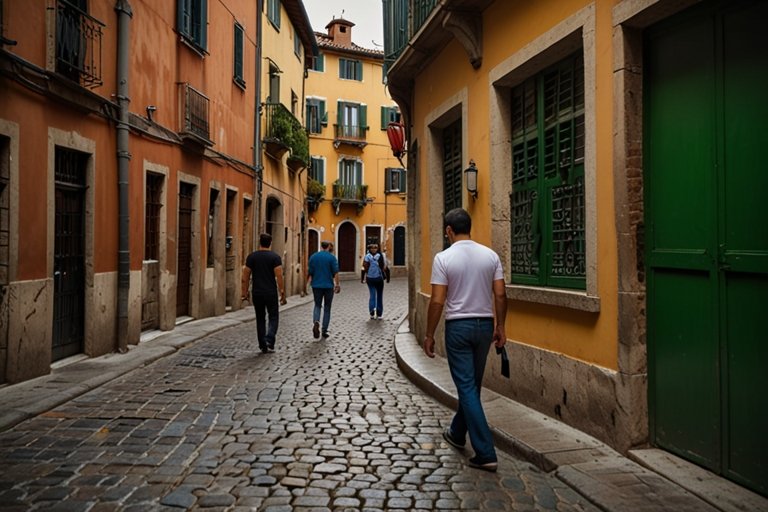Language learners often come across terms that seem straightforward but carry nuanced meanings in different contexts. “Vergando,” the gerund form of the Italian verb “vergare” and the Portuguese verb “vergar,” is one such term. Primarily translating to “bending” or “curving,” “vergando” offers rich linguistic and cultural insights. This article will explore its meanings, uses, and connotations in both Italian and Portuguese, helping you understand its layers and avoid common mistakes.
Vergando in Italian
Explanation of “Vergare” in Italian
“Vergare” in Italian means “to scribe” or “to bend,” depending on the context. Historically, “vergare” referred to marking or engraving with a stick or stylus. Today, it is more commonly associated with physical bending or curving, while its older, poetic sense occasionally appears in literature.
For instance:
- “Il metallo viene vergato facilmente.”
Translation: “The metal bends easily.”
- “Ha vergato il documento con cura.”
Translation: “He carefully inscribed the document.”
The word can convey a sense of artistry when tied to writing or craftsmanship, adding depth to its use.
Examples and Context
The gerund “vergando” expresses an ongoing action:
- “Il vento sta vergando i rami degli alberi.”
Translation: “The wind is bending the branches of the trees.”
- “L’uomo sta vergando le righe su un foglio antico.”
Translation: “The man is tracing lines on an ancient sheet.”
The sentence can change meaning depending on context, adding flexibility to the term’s application in everyday Italian.
Vergando in Portuguese
Explanation of “Vergar” in Portuguese
“Vergar” in Portuguese primarily refers to bending, either physically or metaphorically. Like in Italian, the word can describe the act of curving or yielding to pressure. However, “vergar” in Portuguese often emphasizes resilience and the dynamics of force. For example:
- “O metal vergou sob la pressão.”
Translation: “The metal bent under pressure.”
- “Ele vergou, mas não quebrou.”
Translation: “He bent, but he did not break.”
Examples and Context
“Vergando” is the Portuguese gerund form and is often used to describe ongoing actions:
- “A tempestade está vergando as árvores.”
Translation: “The storm is bending the trees.”
- “Ele está vergando lentamente sob o peso do trabalho.”
Translation: “He is gradually yielding under the weight of the work.”
Regional variations sometimes influence the term’s connotation, deepening its cultural application.
Figurative Uses and Connotations

“Vergando” carries figurative meanings in both languages, representing adaptation, submission, or flexibility. These uses give it a metaphorical richness that transcends the literal act of bending.
- Italian Figurative Use:
- “Era vergando alle circostanze difficili.”
Translation: “He was adapting to difficult circumstances.”
- Portuguese Figurative Use:
- “O líder está vergando diante das pressões políticas.”
Translation: “The leader is yielding under political pressures.”
These figurative expressions often appear in literature or idiomatic contexts, reflecting resilience or transformation.
Comparison of Italian and Portuguese Usage
While “vergando” shares similar core meanings in both languages, subtle differences emerge in usage and emphasis. Italian context often ties “vergando” to more artistic or poetic connotations, whereas in Portuguese, it leans towards resilience and force dynamics.
For instance:
- Italian example: “L’arte sta vergando la pietra nel suo design.”
Translation: “The art is shaping the stone in its design.”
- Portuguese example: “A madeira está vergando pela água.”
Translation: “The wood is bending from the water.”
Historical and cultural influences play a role in these nuanced differences, making “vergando” a fascinating lens into language evolution.
Common Mistakes and How to Avoid Them
Language learners often confuse the literal and figurative uses of “vergando” or misapply its gerund form. Here are some common pitfalls and tips to avoid them:
- Common Mistake 1: Misplacing the gerund in a sentence.
Example: “Vergando está as árvores pelo vento” (incorrect in both languages).
Corrected Example (Italian): “Il vento sta vergando le alberi.”
Corrected Example (Portuguese): “O vento está vergando as árvores.”
- Common Mistake 2: Confusing “vergando” with similar words like “curvando,” which can imply a simpler motion.
Tip: Always check the context to ensure the right choice of word.
To master “vergando,” focus on its collocations and practice constructing sentences in both literal and figurative senses.
Master the Art of Using Vergando
“Vergando” is more than just a verb; it’s a gateway to exploring cultural and linguistic richness in Italian and Portuguese. By understanding its meanings, variations, and common uses, language learners can gain confidence in practical applications. Practice using “vergando” in both literal and figurative contexts, and pay close attention to the nuances that make each language unique.
Immerse yourself in conversations, literature, or films that employ “vergando.” Every language mastery begins with curiosity and practice, so keep experimenting with expressions to refine your skills.
In conclusion, exploring words like “vergando” opens a gateway to deeper cultural appreciation and linguistic proficiency. By dedicating time to understanding its usage and practicing in diverse contexts, you not only enrich your vocabulary but also enhance your ability to connect with speakers of Italian and Portuguese. Remember, language learning is a continuous and rewarding journey—embrace it with enthusiasm and perseverance.
YOU MAY ALSO LIKE
Geöe in Finance, Chemistry, Cooking, and Sustainability
FAQs
1. What does “vergando” mean in Italian?
“Vergando” is the gerund form of “vergare,” meaning “bending” or “curving.” It can also imply scribing or engraving.
2. How is “vergando” used in Portuguese?
“Vergando” is the gerund of “vergar,” primarily describing the act of bending physically or metaphorically.
3. Can “vergando” have figurative meanings?
Yes, in both Italian and Portuguese, it implies flexibility, yielding, or adapting to circumstances.
4. Are there common mistakes to avoid when using “vergando”?
Common errors include misplacing the gerund or confusing it with similar terms. Contextual awareness helps avoid these mistakes.
5. Where can I find more examples of “vergando” in use?
Italian and Portuguese literature, as well as online language forums, are excellent resources for real-world examples.










